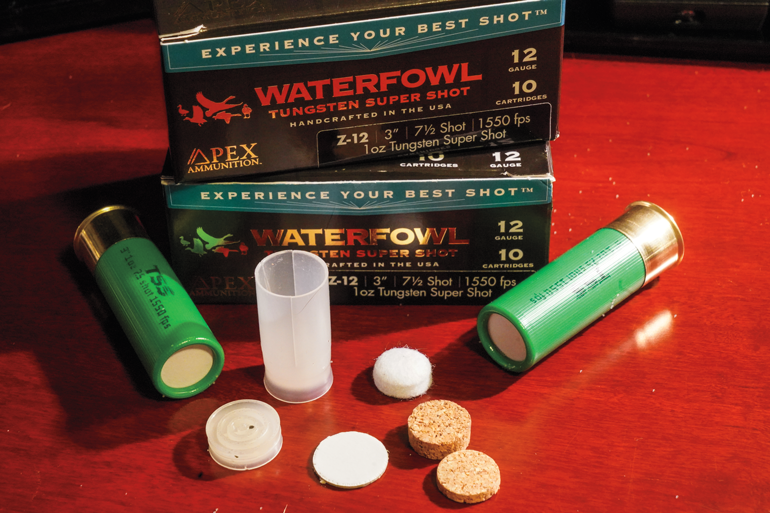
For those not yet on Social Security, we used to shoot lead shot that did a pretty good job of dropping whatever you pointed it at, but it was poisoning ducks that picked it up off the slough and river bottoms. The lead got into their system and either killed them or made them sterile and unable to reproduce, so along came steel shot. Shot pellet killing capacity is measured in terms of grams per cubic centimeter (gr/cm3). Lead comes in between 10.5 and 11 gr/cm3 depending on the alloy, steel is 7.9, bismuth 9.7 and Apex Tungsten Super Shot (TSS for short) at a whopping 18 to 18.5 gr/ cm3. That’s heavy artillery!
TSS is made by blending powdered tungsten, nickel and iron then molding it under extreme pressure. Then, they proceed with sintering or heating it, polishing and finally loading it for us to shoot. TSS is a hard shot so it is not for use in Uncle Zeb’s Model 12 or other shotgun not built to shoot steel shot. Any modern duck gun works. I took Savage’s new Renegauge to the range with a couple boxes of TSS to see how it performed. The Renegauge comes with three Trulock choke tubes. George Trulock and his boys make some fine choke tubes and I checked them against the Renegauge’s cylinder bore (CB) with my digital bore micrometer. Chokes can say what they want on the outside, but it’s the inside and how it compares to the cylinder bore of a shotgun that matters. These were right on the money!
Before I headed to the range, I necropsied a couple of shells. They use a plastic hull with both an over-powder plastic gas seal and a plastic shot cup with four slits. Inside the cup is a ⅜-inch felt wad topped with ⅛- and ¼-inch cork spacers and the shot has a light dusting of Grex plastic buffer. Apex uses a rolled crimp that allows for more space within the hull for the propellant, wads and shot. At one time, the rolled crimp was thought detrimental to good patterns because the over-shot wad interrupted the shot column. However, with shot this hard and the thin over-shot wad, it makes no difference.
I counted 203 and 205 No. 7 ½ TSS pellets from two shells. The I.C. Trulock choke put 67 pellets in the 30-inch circle for an average of 33 percent at 40 yards. This is on the low side of IC, but right on for close ducks over decoys. The Modified tube put a tight-modified 128 pellets in the 30-inch circle for 62 percent, and the Full tube delivered 194 into 30 inches for a whopping 95 percent with 158 pellets in the center 20-inch circle.
Final Specs
Retained pellet energy does the killing and Apex’s 12-gauge TSS No. 7 ½ load at a blistering muzzle velocity of 1,550 fps is calculated at 3.36 ft/lbs at 40 yards. Remember, three to five hits at 1.25 ft/lbs will put ducks in the bag. The 28-gauge No. 9 load hangs a trifle below 1.25 at 1.12 ft/lbs at 40 yards but with the heavy concentration of shot will also take a duck. Keep in mind it’s a lot harder to hit a duck at 40 yards and beyond than to kill it.
Now comes the tough part: the cost. Apex’s website lists their 1-ounce 12-gauge TSS load we tested at $44.99 for a box of 10. Figure in shipping and perhaps tax and that’s bumping up on five bucks a shot. They load a combination-style 1-ounce of steel shot plus ¼ ounce of TSS at $41.99 for a box of 25 and finally their S3 steel shot at a competitive price of $20.99 for 25. As for TSS, lethality is spendy, but when it’s the only shot of the day, it’s cheap at any price. TSS is perfect for bucket list type hunts where you really need a shot to count.
❯❯❯ For further information: Apex Ammunition, 380 Phillips Hill Rd., Columbus, MS 39702; 662-441-2739; info@apexmunition.com | www.apexmunition.com








